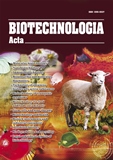ISSN 2410-7751 (Print)
ISSN 2410-776X (Online)

Biotechnologia Acta Т. 17, No. 2 , 2024
P. 78-80, Bibliography 5, Engl.
UDC:: 602:576
DOI: https://doi.org/10.15407/biotech17.02.078
INVESTIGATION OF ENZYMATIC ACTIVITY IN HUMAN DERMAL FIBROBLASTS DURING VARIOUS CULTIVATION PERIODS
A.A. TERESHCHENKO 1, O.K. VORONINA 1, Y.M. KHMELNYTSKA 2, D.M. PYKHTIEIEV 2
1Taras Shevchenko National University, Kyiv;
2 Biotechnological laboratory of the Cord Blood Bank, other human tissues and cells at the M.T.K. Medical Center Pharmaceutical Corporation "ЮРіЯ-ФАРМ", Kyiv
Aim. Research into the change in enzymatic indicators of cell activity during the aging of human dermal fibroblasts in culture from 3 to 15 passages to determine the most optimal terms for cell transplantation to patients for further cell therapy.
Methods: Dermal fibroblasts of donors A, B, and C, aged 40 to 60, were cultivated in сulture medium containing FBS, antibiotics, and bFGF. Cells were fixed with formalin, stained with propidium iodide/RNase buffer to determine the cell cycle, and analyzed using a flow cytometer. To study the enzymatic activity of mitochondria, fibroblasts were seeded in a microplate, and MTT was added, followed by DMSO, and glycine. To determine the activity of lysosomal enzymes, fibroblasts were fixed with formalin, stained with X-Gal, and photographed on a microscope. A statistical analysis of the results was carried out.
Results: Dermal fibroblasts retain their mitotic activity from early to late passages. The average percentage of mitotic cells was higher than the average value of the cells at the interphase. Optical density did not reveal significant changes with the change in the cultivation term. The increase in the formazan level corresponds to a percentage of cells in mitosis. Studying microphotographs of early and late passages to detect cells with enhanced β-galactosidase secretion, no signs of aging of dermal fibroblasts of donors were noticed.
Conclusions: Using various cytochemical methods, it has been proven that the culture of human dermal fibroblasts from donors of the age group of 40 to 60 years maintains stability during their cultivation from 3 to 15 passages.
Key words: human dermal fibroblasts, senescence, cell proliferation, metabolic activity.
© Palladin Institute of Biochemistry of National Academy of Sciences of Ukraine, 2024

